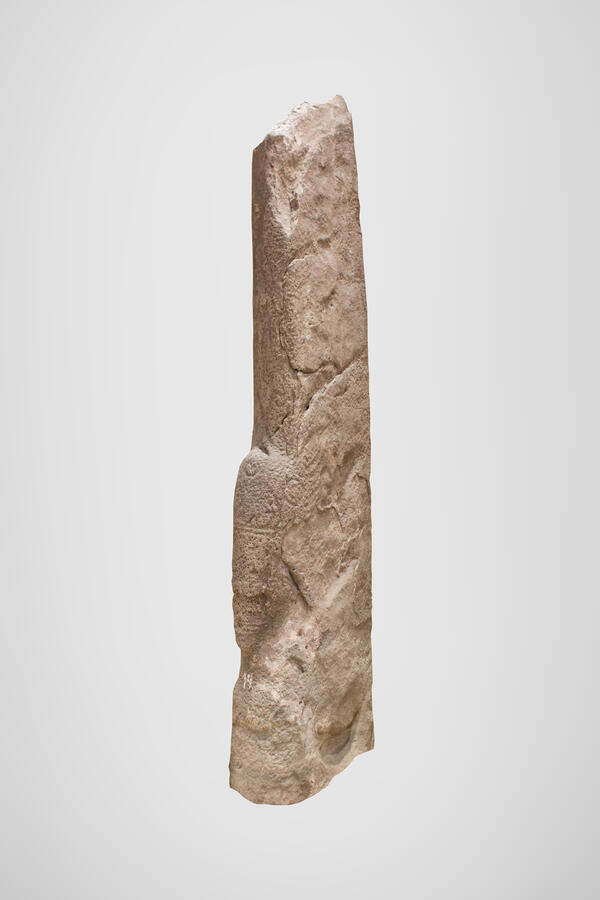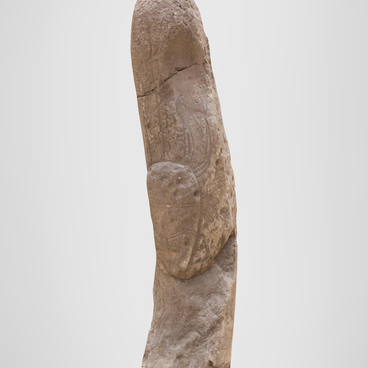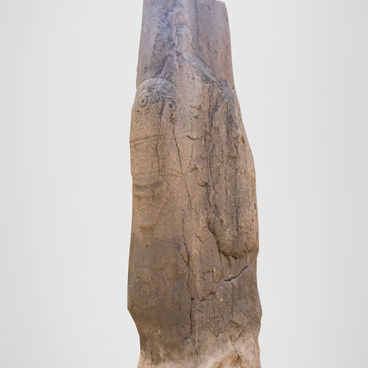Experts date this stone statue with a fantastic mask to the end of the 3rd — beginning of the 2nd millennium BC and refer to the Okunev archaeological culture. This is the name of a group of South Siberian cattle breeders who lived in the territory of modern Khakassia and in the southern part of the Krasnoyarsk Territory in the Bronze Age.
In the Okunev art, stelas played a special role, which were most often installed near burial vaults. Such sculptures were usually made of sandstone or granite and were saber-shaped. On a narrow edge, images of animals or so-called masks were carved. The statue presented in the exhibition belongs to such monuments.
In 1948, it was taken to the museum by archaeologist Albert Lipsky from the memorial of the Tashtyk archaeological culture (1st-5th centuries BC), which was located near the Kyzlas ulus of the Askiz district of the Republic of Khakassia.
The statue is a rectangular pillar made of red sandstone. It reaches 2.5 meters in height, but in antiquity, the stela was higher: its upper part was broken off.
The pillar depicts the face of an ancient deity. The volumetric and convex pattern in profile was created using the technique of picking with subsequent grinding of the lines.
The image of the deity combines zoomorphic and anthropomorphic features. Its face is divided into three parts by horizontal lines. In the upper area, three eyes of a fantastic creature are depicted in the form of circles with dots inside. The central eye is slightly higher than the other two and is separated from them by curved vertical stripes. Also at the top of the face are stylized animal ears. Two oblique crossed lines have been preserved between them.
Two small circles are depicted in the central part of the face. Researchers suggest that they symbolize the nostrils of the deity. The circles are framed by double vertical wavy lines.
In the lower part of the face, the mouth is engraved in the form of a grooved oval strip. The chin is decorated with a horizontal line.
Two symmetrically located circles are carved under the deity himself. Experts believe that this is how the creature’s chest is indicated. And above his head there is a schematic representation of a predatory beast, with its open mouth turned to the mask. A split “snake sting” protrudes from the mouth.
In the Okunev art, stelas played a special role, which were most often installed near burial vaults. Such sculptures were usually made of sandstone or granite and were saber-shaped. On a narrow edge, images of animals or so-called masks were carved. The statue presented in the exhibition belongs to such monuments.
In 1948, it was taken to the museum by archaeologist Albert Lipsky from the memorial of the Tashtyk archaeological culture (1st-5th centuries BC), which was located near the Kyzlas ulus of the Askiz district of the Republic of Khakassia.
The statue is a rectangular pillar made of red sandstone. It reaches 2.5 meters in height, but in antiquity, the stela was higher: its upper part was broken off.
The pillar depicts the face of an ancient deity. The volumetric and convex pattern in profile was created using the technique of picking with subsequent grinding of the lines.
The image of the deity combines zoomorphic and anthropomorphic features. Its face is divided into three parts by horizontal lines. In the upper area, three eyes of a fantastic creature are depicted in the form of circles with dots inside. The central eye is slightly higher than the other two and is separated from them by curved vertical stripes. Also at the top of the face are stylized animal ears. Two oblique crossed lines have been preserved between them.
Two small circles are depicted in the central part of the face. Researchers suggest that they symbolize the nostrils of the deity. The circles are framed by double vertical wavy lines.
In the lower part of the face, the mouth is engraved in the form of a grooved oval strip. The chin is decorated with a horizontal line.
Two symmetrically located circles are carved under the deity himself. Experts believe that this is how the creature’s chest is indicated. And above his head there is a schematic representation of a predatory beast, with its open mouth turned to the mask. A split “snake sting” protrudes from the mouth.



